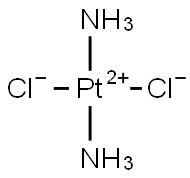
15663-27-1
| Name | Cisplatin |
| CAS | 15663-27-1 |
| EINECS(EC#) | 239-733-8 |
| Molecular Formula | Cl2H6N2Pt |
| MDL Number | MFCD00011623 |
| Molecular Weight | 300.05 |
| MOL File | 15663-27-1.mol |
Chemical Properties
| Appearance | Crystalline |
| Melting point | 270 °C (lit.) |
| bulk density | 850kg/m3 |
| density | 3,7 g/cm3 |
| storage temp. | 2-8°C |
| solubility | Soluble in DMF. Insoluble in most common solvents |
| form | crystalline |
| color | yellow |
| Stability: | Stable. Incompatible with oxidizing agents, aluminium, antioxidants. |
| Water Solubility | <0.1 g/100 mL at 19 ºC |
| Usage | Used as an antineoplastic |
| Merck | 14,2317 |
| Exposure limits | ACGIH: TWA 0.002 mg/m3 NIOSH: IDLH 4 mg/m3; TWA 0.002 mg/m3 |
| CAS DataBase Reference | 15663-27-1(CAS DataBase Reference) |
| IARC | 2A (Vol. 26, Sup 7) 1987, 1 (Vol. 76, 100A) 2012 |
| EPA Substance Registry System | 15663-27-1(EPA Substance) |
Safety Data
| Hazard Codes | T |
| Risk Statements | |
| Safety Statements | |
| RIDADR | UN 3288 6.1/PG 2 |
| WGK Germany | 3 |
| RTECS | TP2455000 |
| F | 10-21 |
| TSCA | Yes |
| HazardClass | 6.1(a) |
| PackingGroup | II |
| HS Code | 28439090 |
| Safety Profile | |
| Hazardous Substances Data | 15663-27-1(Hazardous Substances Data) |
| Toxicity |
